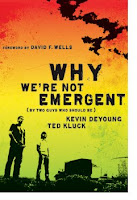Review: One Church, Many Congregations
 One Church, Many Congregations is a fascinating little book. Written from an American Baptist context it explores what the authors call the “Key Church Strategy.” While the book is very closely tied to this strategy and occasionally assumes some familiarity with both the Strategy and its associated material and jargon, it does put forward some sound principles for revitalising church through mission.
One Church, Many Congregations is a fascinating little book. Written from an American Baptist context it explores what the authors call the “Key Church Strategy.” While the book is very closely tied to this strategy and occasionally assumes some familiarity with both the Strategy and its associated material and jargon, it does put forward some sound principles for revitalising church through mission.
The fundamental premise is this – that “the most effective – and often the lowest cost – way to reach new generations… with the gospel of Jesus Christ is through new worshiping communities.” (Page 11). Unashamedly, “The most effective form of evangelism is church starting.” (Page 135). Here is a holistic view of evangelism that avoids utilitarian and overly-pragmatic views on the most efficient ways of winning souls. It recognises that not only do people (as in persons) reach people for Jesus but people (as in congregations) are necessary to reach people for Jesus. The idea is this – if you want to grow the church, plant and nurture new congregations and missions.
While it’s never explicitly spelled out (something of a frustration) it appears that the Key Church Strategy revolves around breathing life into old churches through enabling that church to plant other churches or satellite ministries. In their chapter on “Foundations” the authors look towards NT history to pattern a model of evangelism-by-church-planting.
The most useful thing they extract from the biblical pattern is the “Indigenous Principle.” Having already illustrated the idea earlier when talking about an outreach to a local apartment community in which “a pastor from the community” is “enlisted and trained” (Page 23) it is explained:
“The indigenous missions principle states that congregations are healthier and more productive, and require little or no outside support, when started and developed in the context of the socioeconomic condition and culture of the people who are to be evangelized or congregationalized.” (Page 32)
Here we see the holistic nature of the Strategy: we find mentoring and leadership-development at the heart of mission and evangelism. They include the exhortation to “Teach members of the church planting teams to replace themselves by enlisting residents indigenous to the target community and teaching them to be leaders.” (Page 35). Without knowing the strategy, this is the sort of thing that has been happening at Connections and which needs to happen further if we are to build significantly onto some of the inroads we are making, as a community, into different socioeconomic groups.
The insights are not restricted to the churches being planted but fundamentally to the church doing the planting. The authors see the role of the Key church as sponsorship or partnership:
“…sponsorship is a partnership between the new church the new church congregation and the established church. Each partner supplies some expertise and resources needed to begin and grow a new church… The goal of sponsorship is for the sponsoring church’s presence to decrease as the new congregation grows. The sponsor can call itself successful if it works itself out of a job.” (Page 37)
This stuff is dear to my heart and of great relevance to myself as I consider my own ministry of context of the Parish of Burnie where we find ourselves multi-congregational and needing to implement changes in governance and other structures that recognise this sort of partnership and allow a network of partnerships to emerge. The structure they put forward (a “Key Church Council”) would not readily apply to my context, but the principles are sound: “A necessary part of any church ministry strategy is the establishment of an organizational structure that will do more than simply meet and make decisions. Good organizational structures facilitate ministry, not merely debate it.” (Page 53). That’s close to home.
For the potential “Key Church” the idea is that revitalisation comes through embracing a willingness to invest internally by focussing externally. The vision is not a myriad of uncontrollable, resource-draining programs hanging of an old structure – but genuine outreaches that aspire to the “three-selfs” of maturity (self-supporting, self-governing, self-extending). Even when there is ongoing connection with the centre (in the so-called “Indigenous Satellite Strategy”) and the outreach remains a “permanent part of the sponsoring church” (Page 79), the aspiration is still towards this sort of maturity, and to a mutual understanding that “the resources are in the harvest” (Page 81) and that there is blessing in investing in a number of demographically homogenous units that allows the church network as a whole to be a hetereogenous community (see Page 83).
There are numerous practical suggestions. From a list of “temptations to avoid” when enlisting a core group (Page 114) to guidelines in the appendix that run to detail such as financial arrangements (“tithes and offerings should be pooled and a separate checking account opened in the name of the new congregation.” (Page 132))
Like all ministry-management books it is never a direct match for one’s own context that can be directly copied. But there is decades of experience here in a model of doing church and growing the kingdom that beats close to my own heart and the necessary direction for our own church. I’m glad to have a had a glimpse and pray to know the same wisdom in the here and now. And it is stirred me to not simply be content with ensuring the church machine continues to tick over, but seeing it accelerate.










